Change is the only constant in life.
—Heraclitus, a Greek philosopher
Note: This article is part of Extended SAFe Guidance and represents official SAFe content that cannot be accessed directly from the Big Picture. Read the SAFe 6.0 Upgrade FAQ here or the General SAFe 6.0 FAQ here.
What’s New in SAFe 6.0
We are delighted to announce that SAFe 6.0 offers the newest and most effective Lean-Agile practices, enabling forward-thinking enterprises to navigate today’s rapidly changing challenges and opportunities.
Why SAFe 6.0?
The unprecedented times of the pandemic only emphasized a reality that has been decades in the making—Enterprises are overwhelmed by constant change. Between Customer expectations, supply chain complexities, and the impact of digital technology, the pace of change has never been faster, or the change itself has become more unpredictable.
For thousands of global organizations and government agencies, SAFe has become integral for adapting to change, building resiliency, and thriving as a modern, digital business. Meeting the new realities of the marketplace requires SAFe to evolve continuously. While we’ll never lose sight of SAFe’s core benefits, our guidance continually improves to address new and emerging challenges.
Work Differently. Build the Future.
Our new tagline, “Work Differently. Build the Future,” represents the idea that our work enables us to innovate faster to successfully navigate any market disruption or opportunity. What does it mean to work differently? For starters, it’s increasingly clear—and now proven—that the entire organization needs to work with the same Lean-Agile mindset and practices. From marketing and finance to security and HR and everyone in between, this is how today’s most successful enterprises align strategy to execution and meet current and future customer expectations.
Integrating emerging technologies (such as AI, Big Data, and Cloud) into our Value Streams is a growing component of working differently. They are changing the nature of application development and will determine if an organization will succeed. Moreover, the pressure to accelerate the flow of value and deliver measurable business outcomes is unrelenting. The power of the Agile Team has never been more critical in achieving this.
Say Hello to SAFe 6.0!
SAFe 6.0 is a comprehensive update from version 5.1 and includes many new and advanced practices alongside a new Big Picture (BP) and terminology updates (Figure 1).
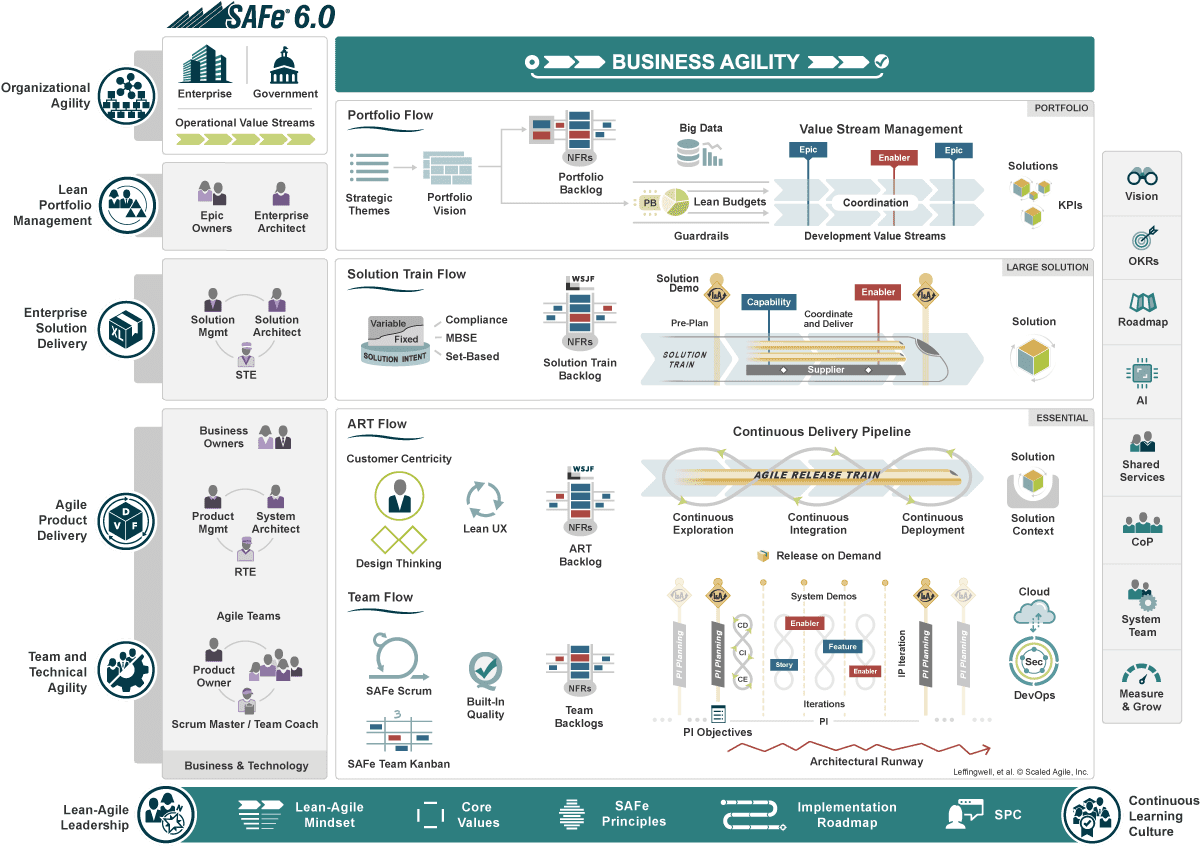
The SAFe 6.0 update has six primary themes, as illustrated in Figure 2:
Each of these themes is described in the following sections:
1. Strengthening the Foundation for Business Agility
Everything moves fast in the digital age. Customer desires, competitive threats, technology choices, business expectations, revenue opportunities, and workforce demands now happen at blistering speeds. To address these challenges, Business Agility is needed to compete and thrive in the digital age by quickly responding to market changes and emerging opportunities with innovative, digitally-enabled business solutions.
The fundamental aspects of business agility, including the Business Agility Value Stream (Figure 3) and SAFe Foundation (Figure 4), are substantially updated to improve support for working differently and building the future. Updates to the SAFe Implementation Roadmap and revised responsibilities for SPCs clarify the path for navigating the change. Details include:
- Business Agility Value Stream (BAVS) – The newly introduced BAVS has been added to the top of the Big Picture, leading the way for competing and thriving in the digital age. It helps organizations quickly respond to market changes and emerging opportunities with innovative, digitally-enabled business solutions.
- SAFe Foundation — All articles illustrated by the icons in Figure 4 were enhanced to further strengthen their support for business agility, along with the following design changes:
-
- Lean-Agile Mindset – The Lean-Agile mindset is represented by the five principles of Lean Thinking and the Agile Manifesto (Figure 5).
-
- The House of Lean has been retired since all its tenets have been embodied and amplified throughout the Framework. For example:
-
-
- Respect for people is now a SAFe Core Value since it’s a basic human need. Treating people respectfully unlocks their intrinsic motivation to learn and grow, evolve their practices, and contribute to their business and customer outcomes.
- Flow is covered in the new SAFe Principle #6 – Make value flow without interruptions and anchors Value Stream Management (VSM).
- Innovation is part of the Continuous Learning Culture competency, which has been added to the SAFe foundation and will be expanded in future releases.
- Relentless improvement became a SAFe core value since the relentless pursuit of perfection has always been one of the core tenets of Lean. While unattainable, striving for perfection leads to continuous improvements of products, services, and processes.
- Core values – SAFe’s four core values (Figure 6) were changed to alignment, transparency, respect for people, and relentless improvement resulting from the previously described changes. Moreover, they were replaced to avoid redundancy with other concepts. For example, Built-in Quality is enhanced as a dimension of the Team and Technical Agility core competency, and an article with the same name.
-
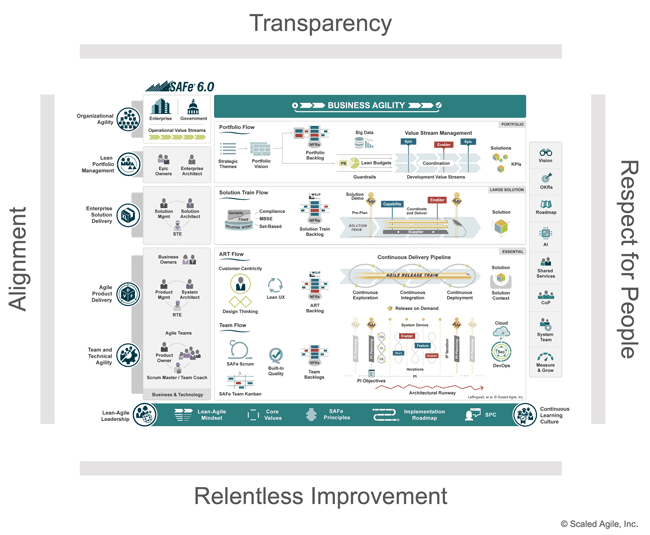
-
- SAFe Principles – Principle #6 was changed and is now aligned with the five principles of Lean Thinking (Figure 7). It also highlights the eight common properties of a flow-based system and provides specific accelerators for eliminating impediments to flow.
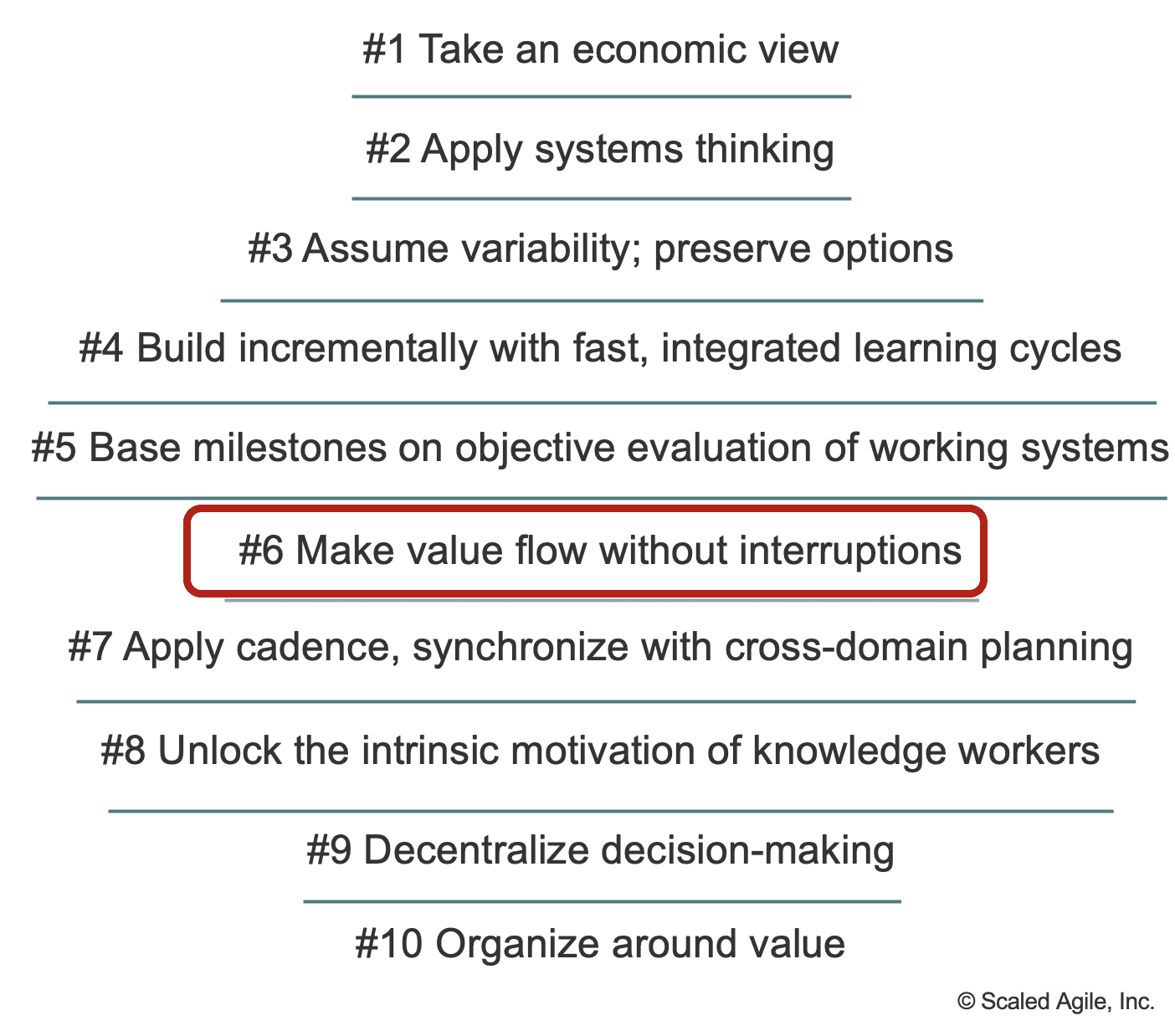
-
- SAFe Implementation Roadmap – The SAFe Implementation Roadmap, which provides the critical moves for adopting the Framework, was updated to reflect the changes in SAFe 6.0 (Figure 8):
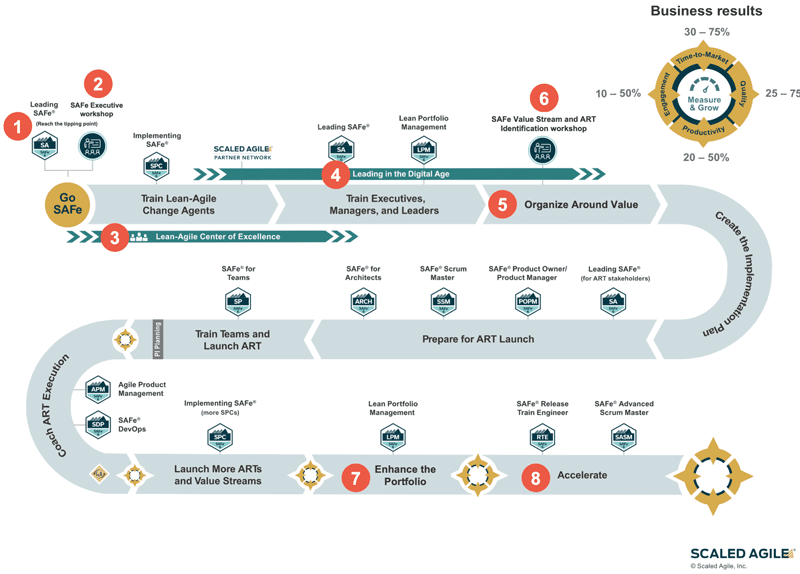
-
-
- Waterfall / Ad Hoc Agile step was removed as the starting point since SAFe adoption does not always begin from one of these starting points.
- SAFe Executive Workshop toolkit was added to the ‘Go SAFe’ step.
- Lean-Agile Center of Excellence – refined and clarified its responsibilities.
- Leading in the Digital Age was added to the roadmap, a program that equips leaders with the knowledge and skills to support their Agile Teams and manage change effectively.
- Organize Around Value was renamed from Identify ARTs and Value Streams to reflect its purpose and connection to Principle #10.
- SAFe Value Stream and ART identification workshop toolkit was added to the ‘Organize Around Value’ step.
- Enhance the Portfolio was renamed. It was previously called Extend to the Portfolio. This updated step recommends that organizations start exploring some LPM practices earlier in their journey, such as implementing a Portfolio Kanban System to provide visibility of current and future initiatives. Therefore, LPM training is recommended during the ‘Train the executives, managers, and leaders’ roadmap step.
- Accelerate emphasizes that the transformation journey is never-ending, starting with a focus on creating a Continuous Learning Culture that commits to relentless improvement and promoting a culture of innovation.
-
-
- SAFe Practice Consultants (SPCs) – formerly known as SAFe Program Consultants, SPCs provide coaching for many of the practices and critical moves described in the SAFe Implementation Roadmap. They also must work beyond the roadmap as a group of change agents with unrelenting energy, bringing business agility to the organization over time through executing the areas of responsibilities seen in Figure 9.
-
- Continuous Learning Culture (CLC) – The CLC competency was added to the foundation to make it part of all SAFe configurations. Previously, it was not part of the Essential SAFe configuration.
2. Empowering Teams and Clarifying Responsibilities
Nothing beats an Agile Team, and further enhancing performance requires clearer and more explicit responsibilities for each SAFe role. New and improved guidance is needed to help people improve their job performance and better support the organization’s goals.
- The following role articles were updated to illustrate and describe their responsibilities better. Selected thumbnails from these articles are highlighted in Figure 10.
- Agile Release Train
- Agile Teams
- Business Owners
- Enterprise Architect
- Epic Owners
- Lean Agile Center of Excellence
- Product Owner
- Product Management
- Release Train Engineer
- SAFe Practice Consultant
- Scrum Master/Team Coach
- Solution Management
- Solution Train Engineer
- System Architect
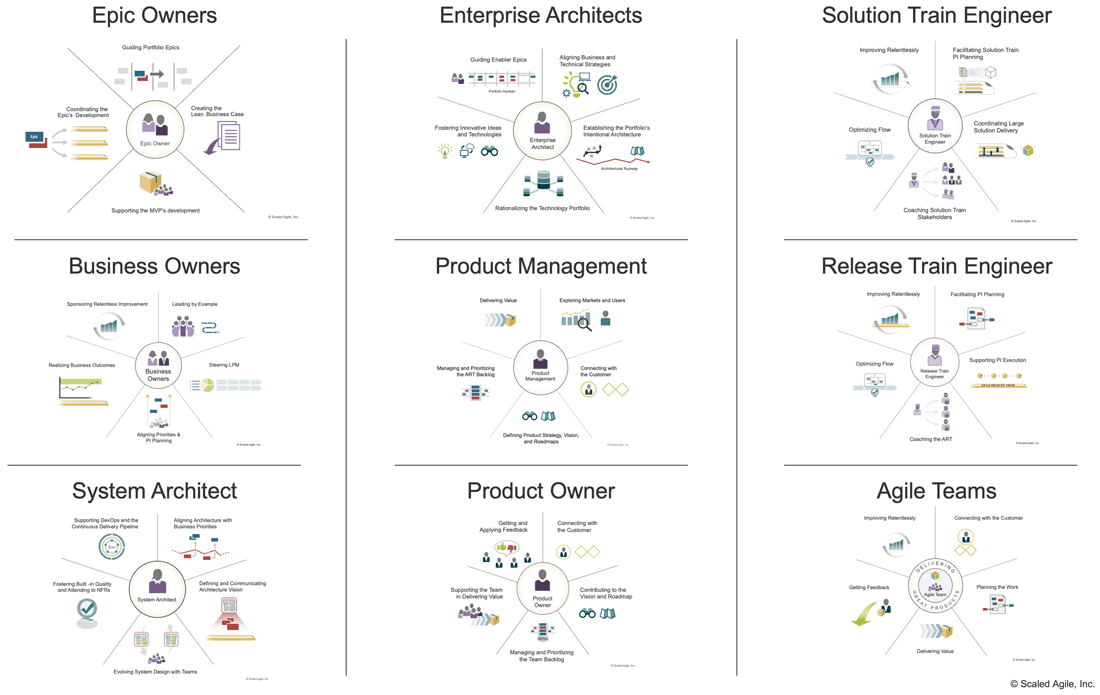
- Scrum Master/Team Coach – The Scrum Master/Team Coach now has broader responsibilities for optimizing flow, building high-performing teams, and supporting organizational agility (Figure 11). Organizations can choose the role name Scrum Master, or Team Coach, whichever is best suited for their context.
- Agile Release Trains (ARTs) – The ultimate purpose of ARTs is to deliver effective solutions to customers. It’s fundamental for establishing a fast flow of solution features. ARTs develop solutions iteratively, constantly engaging with the customer and adjusting their course of action toward an optimal solution. Understanding their responsibilities is critical for success (Figure 12). To this end, a ‘responsibility wheel’ was created for ARTs to clarify their duties at-a-glance.
- Key collaborations – Converting ideas into a steady stream of valuable products and services is a complex endeavor that requires ongoing coordination and communication. Four role articles with content authority were updated to include the collaborative partnerships needed to enable quick and efficient product development flow (Figure 13). Although these roles are integral to successful value delivery, no one has all the domain knowledge or capacity to do it alone.
3. Accelerating Value Flow
Being competitive in today’s fast-paced world means accelerating value flow is an essential survival skill in the digital age.
SAFe 6.0 defines the eight properties of flow and, with an updated SAFe Principle #6, introduces eight related ‘flow accelerators’ that can make value flow faster. Furthermore, brand new SAFe Scrum, SAFe Team Kanban, Built-in Quality, and Value Stream Management articles incorporate flow directly into the teams’ daily work.
- Eight common properties of flow describe how SAFe defines flow, as illustrated in Figure 14.
- Eight flow accelerators – Figure 15 illustrates how the eight flow accelerators help make value flow without interruption (Principle #6). These powerful accelerators of value are relevant to all Framework levels, but the challenges differ for each.
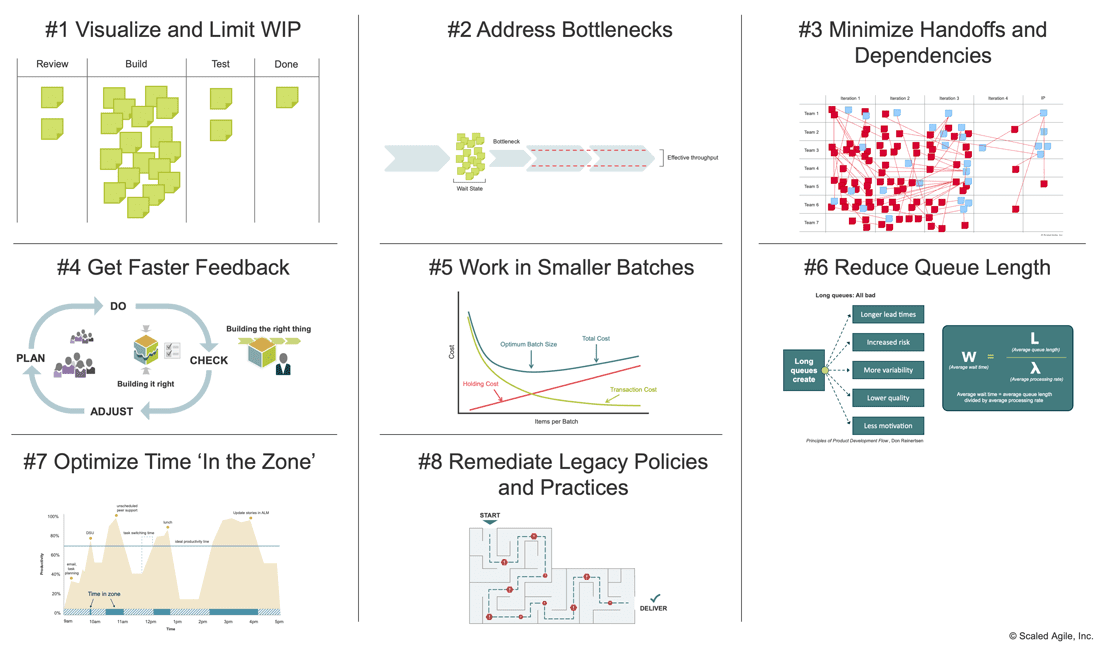
- Four new flow articles, Team Flow, ART Flow, Solution Train Flow, and Portfolio Flow, describe applying the eight flow accelerators from Principle #6. These articles can be accessed from the icons shown in Figure 16. Each offers techniques for addressing, optimizing, and debugging issues with a continuous value flow for that specific level.
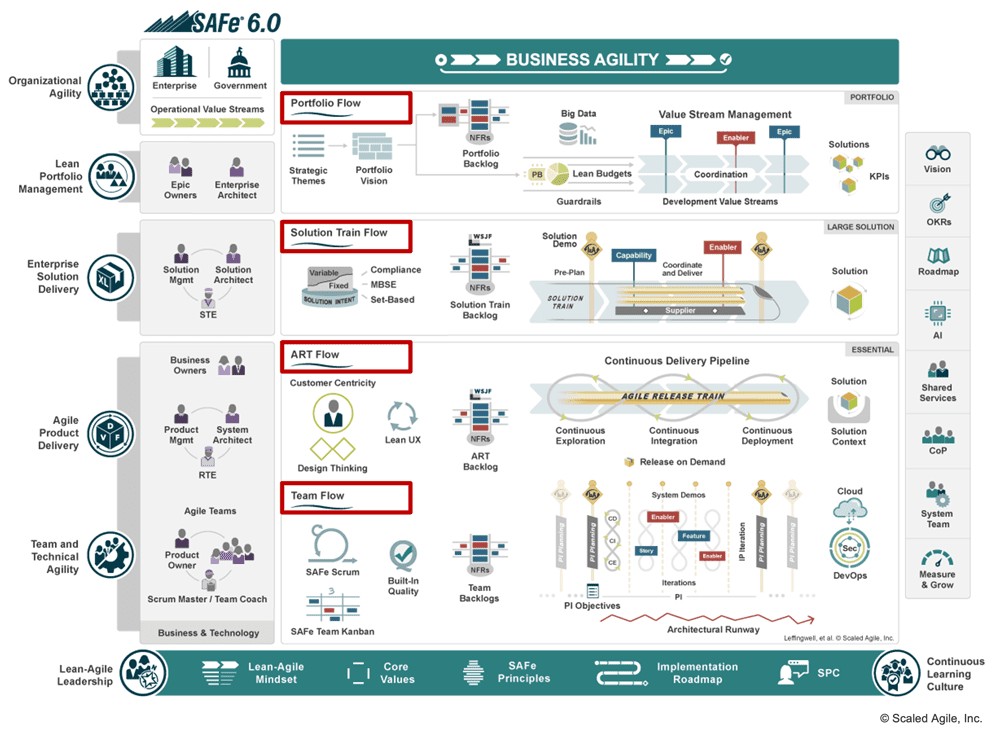
- SAFe Team Kanban is a Lean-Agile method (Figure 17) that helps Agile Teams facilitate the flow of value by visualizing workflow, establishing Work in Process (WIP) limits, delivering value continuously, measuring throughput, and improving their process. The article has been renamed from Kanban to ‘SAFe Team Kanban’ and was significantly revised to explain how to use Kanban for SAFe teams, which operate as part of an ART.
- SAFe Scrum replaces Scrum XP, and the XP-inspired practices were moved into Built-in Quality and other articles. In addition, the Scrum keystone image (Figure 18) was enhanced to illustrate how to apply Scrum in SAFe.
The 5.1 icons for Plan (Iteration Planning), Review (Iteration Review), Retro (Iteration Retrospective), and Execution were removed from BP and are now accessed from the Scrum article. The content from Iteration Execution was merged into the Iterations article.
- Built-in Quality – SAFe 6.0 provides a new innovative approach to built-in quality across all technology and business domains, illustrated in figure 19. This model starts with basic Agile Quality practices that apply universally. These are shift learning left, pairing and peer review, collective ownership, T-shaped skills, artifact standards and definition of done, and workflow automation. The model builds on this foundation with quality practices that apply to specific domains such as business functions, software applications, IT systems, hardware, and cyber-physical systems.
- Value Stream Management (VSM) – VSM was previously an extended guidance article. It was added to the Big Picture (Figure 20) to emphasize it as a Portfolio Level responsibility. It was also enhanced to provide new guidance about the triads that manage the value stream.
- Value Management Office (VMO) – The VMO was previously called the Agile Program Management Office (APMO), and its focus has changed to provide more support for understanding, measuring, and improving the flow of value.
The Value Management Office (VMO) supports portfolio flow, and its responsibilities include:
-
- Helps define the scope of the portfolio
- Supports improving the flow of value delivery
- Facilitates strategy formulation and helps communicate strategic themes
- Facilitates the Portfolio Sync
- Works with the LACE to develop, harvest, and apply successful ART execution patterns across the portfolio
- Facilitates Lean budgeting and governance
- Fosters decentralized PI Planning and operational excellence
- Fosters more Agile contracts and leaner supplier and Customer partnerships
- Applying Kanban in SAFe – Created a new Applying Kanban in SAFe extended guidance article to provide an overview of Kanban, how to establish a Kanban system, and describe SAFe’s connected Kanban system. Figure 21 offers some key images from this new content.
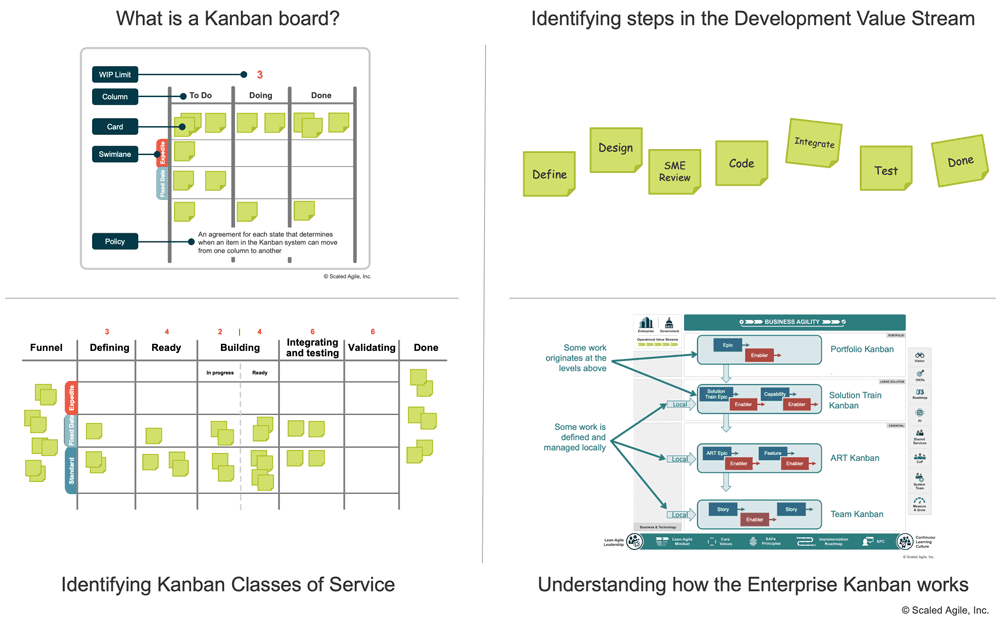
4. Enhancing Business Agility with SAFe across the business
A Lean-Agile transformation will touch every part of the organization. As one part accelerates, it reveals bottlenecks in the others. Therefore, business agility requires everyone to learn how to perform their work better by applying Lean-Agile principles – optimizing flow, working with small batches, building-in quality, organizing around value, using systems thinking, and more – in their context.
- Business & Technology – The significantly updated Business and Technology article highlights five business and technology patterns (Figure 22), including business-enabled ARTs, launching business trains, creating an Agile executive team, applying SAFe to other business functions, and combining development and operational value streams within the same portfolio. Each is described in the following paragraphs.
-
- Business-Enabled ART – An ART that includes the technical and business people needed to ensure the solution is aware of the industry in which it operates and that it addresses the relevant concerns for the technology, business, and customer.
- Agile Business Train is a further step towards agility. An Agile Business Train contains one or more SAFe Operational Value Streams and all the ARTs needed to define, build, deploy, operate, and commercialize a complete business solution.
- Agile Executive Team – The Agile executive team aligns senior leadership across the organization to run the company as a team, communicate strategy and vision as one voice, and align on strategic Work-In-Progress.
- Agile Business Function – is an organizational unit that utilizes Lean-Agile methods and SAFe principles to streamline its operations and create transparency in its value delivery.
- Combined Portfolio – A combined portfolio is a type of SAFe portfolio that includes both Development and Operational Value Streams. A combined portfolio provides clear strategic funding decisions and alignment for a blended set of solutions within a business segment.
- SAFe beyond IT home page provides access to articles about real-world business agility experiences in Operational Value Streams. Contributed and written by SAFe professionals, they describe their successes and challenges in extending Lean, Agile, and SAFe practices to Finance, Marketing, Human Resources, Legal, Operations, and other functions beyond IT.
5. Building the Future with AI, Big Data, and Cloud
SAFe offers new guidance on harnessing three innovative technologies that dramatically change the nature of software and systems development: AI, Big Data, and Cloud. Applying these technologies is becoming critical for competing now and in the future. There are three new articles and icons on the BP:
![]()
- AI (Artificial intelligence) – has been added to the spanning palette. It describes a wide range of intelligent machines capable of performing tasks that typically require human intelligence. It is a technology that can revolutionize solutions developed by SAFe organizations and has the potential to dramatically influence the operational and business models of enterprises as well.
![]()
- Big Data – SAFe addresses Big Data concerns at the portfolio level as it requires vision, investment, and governance at the highest levels in the organization. While ARTs create the data, the value comes from data aggregation at the portfolio and enterprise. Big data requires strategic investment from the most significant parts of the organization and a comprehensive approach that aligns each of the organization’s development value streams to the same DataOps practices to produce cohesive data sets used across the entire organization.
![]()
- Cloud – The ever-expanding universe of cloud capabilities has fundamentally changed how digitally enabled solutions are built, deployed, and maintained. Cloud computing is the single most disruptive driver of delivery model change that enterprise IT has faced since its inception. Not surprisingly, the number one reason enterprises are moving to the cloud so quickly is to increase product development speed and agility.
6. Delivering Better Outcomes with Measure and Grow and OKRs
- Measure and Grow – The metrics icon on the spanning palette was renamed Measure & Grow. The content includes SAFe’s three measurement domains (Outcomes, Flow, and Competency), as illustrated in Figure 23. This approach enables measuring progress toward business agility at all levels of SAFe. The insights they provide support better decision-making and help identify opportunities for improvement.
- OKRs were added to the spanning palette that links to a new guidance article. It provides three main use cases for OKRs illustrated in Figure 24 and described next. OKRs can offer an effective tool to help drive better outcomes for the business and customers. The usage of OKRs within SAFe is optional. However, OKRs are generally the best way to describe the portfolio’s Strategic Themes.
- Enhancing strategic alignment across a SAFe portfolio – The goal of using OKRs for Strategic Themes is to define and track their progress through concrete, specific, and measurable actions.
- Defining business outcomes for epics and Lean business cases – Use OKRs to help to uncover potential Epics for entry into the Portfolio Kanban system. Defining epics with OKRs definition provides clarity for the desired business outputs and outcomes.
- Setting improvement goals for the SAFe transformation – Applying OKRs can be used to measure the success of a SAFe change program.
Other important changes
- A Kanban system manages all SAFe backlogs – Each backlog is visualized in a Kanban system (Figure 25). Therefore, each backlog system and its related Kanban article have been merged to simplify guidance and remove redundancy. Other associated changes include:
- Removing the vertical Kanban label from all backlog icons
- Changing the Backlog state in all Kanban systems to ‘Ready,’ which reduces the confusion between the Kanban state and the backlog itself

- Spanning palette changes -The following changes were made to provide better support for SAFe 6.0 (Figure 26):
- OKRs were added to the palette.
- Milestones were merged into the new Roadmap article and removed from the palette.
- AI (Artificial Intelligence) was added to the palette. It was previously an extended guidance article.
- Lean UX was moved off the spanning palette to the body of the BP next to Customer Centricity and Design Thinking, showing its relationship and importance to those two practices.
- Measure and Grow was renamed from metrics
- Enterprise Solution Delivery – Based on field experience and customer feedback, the following articles were significantly improved to describe better how Solution Trains manage planning and deliver solutions (Figure 27):
- Pre-Plan replaced Pre-PI planning. It describes the Solution Train activities necessary to prepare ARTs for PI Planning.
- Coordinate and Deliver replaced Post-PI planning. This update describes the practices to deliver Large Solutions across multiple ARTs and suppliers in a Solution Train.
- Standardize ART terminology – The terminology for program was replaced throughout the Framework with ART. Standardizing this terminology improves simplicity and clarity.
- Standardize solution terminology – Solution Train artifacts and events were standardized (Table 2).
- Other terminology changes made for consistency are shown in Table 3 below.
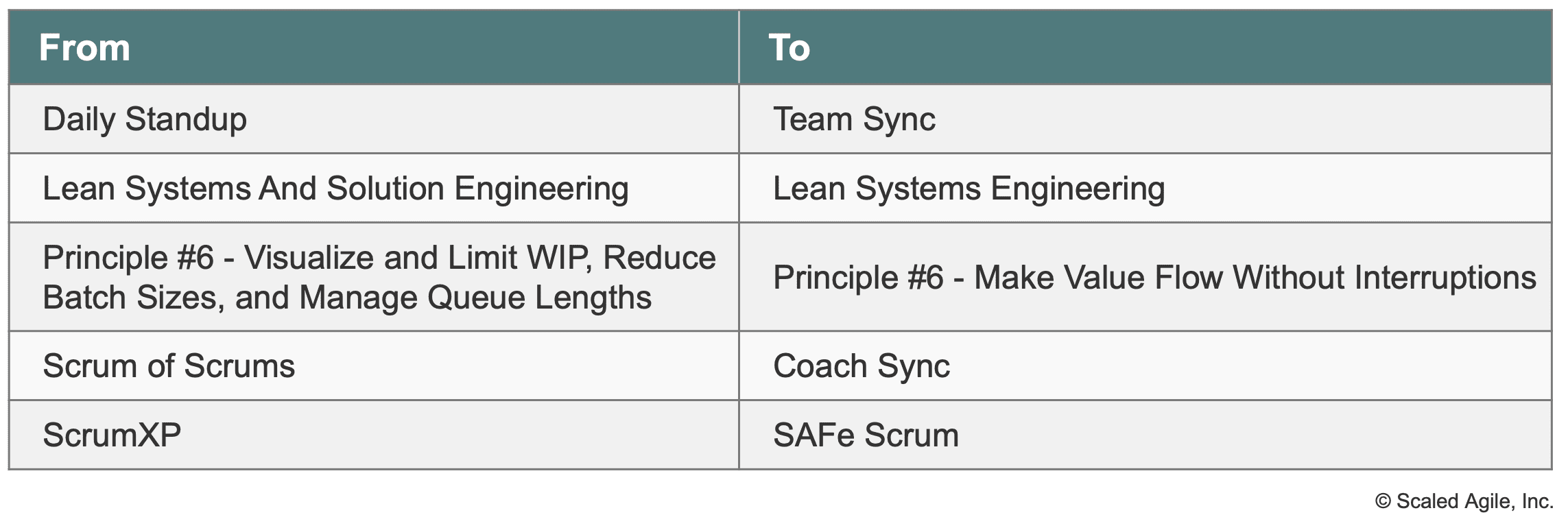
Last update: 2 January 2023